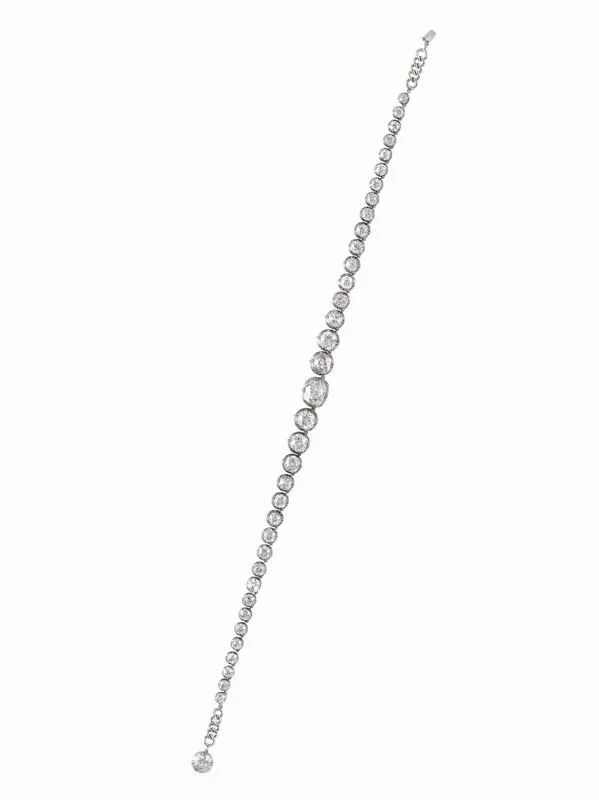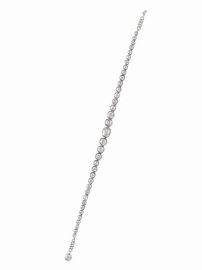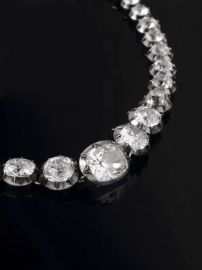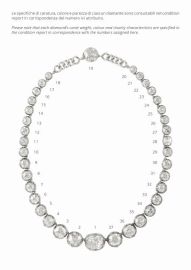NECKLACE, MID-19TH CENTURY
IN DIAMONDS, SILVER AND WHITE GOLD
the strand composed of thirty-seven old cushion shaped diamonds graduated from ct 8.50 to ct0.45, total weight ct 64.00 approximately, colour J/O, clarity VS2/I2, each mounted on an eightprongs cluster in silver; on the back a chain of silver links and a gold clasp mounting a diamondwere added afterwards as an extension, the seven center clusters are equipped with pendanthooks, length cm 43
Provenance
Royal Princess Louise Victoria Alexandra, Duchess of Fife;
Dukes of Fife, heirs of the Royal Princess;
Private collection
We are very proud to present in this catalogue a magnificent necklace of the mid-19th century: our research led to a photographic documentation dating back to about 1860 when a very similar specimen, probably the very same, was captured on the Royal Princess of Denmark, Alexandra Caroline Marie Charlotte (1844-1925), wife of the future King of England Edward VII (1841-1910).
This jewel reached the international market in the early 1970s when it was auctioned at Sotheby's in London with other pieces belonging to the Dukes of Fife, related to the House of Windsor through the marriage of Alexander William George Duff, First Duke of Fife (1849-1912) and the Royal Princess of England, Louise Victoria Alexandra of Wales (1867-1931), daughter of the abovementioned royal couple.
In occasion of her marriage celebrated in 1889, the Duchess of Fife received from the royal guests what was described as a "cascade of jewels", that was exhibited in the large dining room of the family residence at Marlborough House. The rich ornaments were meticulously described in the main newspapers of the time. Therefore, this necklace was probably one of Louise’s parents wedding gifts.
In an official image, dated about 1900, the Royal Princess stands next to her husband clearly wearing this necklace.
The same collier can also be recognized in a picture, dated 1907, in which Louise is portrayed next to her mother, His Royal Highness Alexandra, at the time Queen of England, and her sister the Princess Victoria Alexandra Olga of Wales (1868-1935) while wearing this necklace and another jewel belonging to the Windsor family: the famous 'Fringe tiara'.
Unfortunately, many of Louise's royal jewels got lost in the Mediterranean sea when the vessel taking the Dukes of Fife to Egypt shipwrecked near the coasts of Morocco in 1911. The necklace, however, survived the accident as evidenced by numerous pictures of Louise's daughter, Alexandra Victoria Alberta Duff, Duchess of Fife (1891-1959), photographed with the family's precious jewel.
One of women's most beloved ornament, the collier reached its highest diffusion among the European ladies in the nineteenth century when diamonds were particularly sought after in the United Kingdom as a symbol of social status both for aristocracy and upper-middle class. Besides colliers composed of one or more diamond rows, multi-strand pearls and semi-precious stones necklaces became very popular in the English society.
Alexandra was considered an icon of style by her circle, therefore her unusual habit of wearing very short necklaces, perhaps to hide a scar on her neck, started the still ongoing trend of the so called ‘collier de chien’.
This precious necklace well represents the evolution of this type of jewel throughout the nineteenth century. If compared with the previous century style, closed mountings give way to opened clusters that let the light pass through the stones thus maximizing their brilliance; the traditional cushion shaped cut becomes rounder, getting close to what will be the modern round brilliant cut.
The seven center clusters highlight the close attention paid to details: each one is equipped with hidden hooks to hang additional pendants meant to give the necklace a richer look.








